We all know it doesn’t really rain cats and dogs, but when it comes to other pet myths, are we as knowledgeable as we think? Misinformation can spread faster than a greyhound can run, so we ran a survey of more than 2,000 UK pet owners (and non-pet owners) to separate the facts from the furballs.
Here’s just a taster of what we found:
- Nearly half (49%) of pet owners believe that a wagging tail means a dog is happy. And over a fifth (21%) of people believe that dogs don’t see in colour.
- Labradors are seen as the most loyal dog breed (21% of respondents) while Persian cats (8%) came top as the most loyal cat companion.
- Almost a fifth (18%) of pet owners have avoided certain foods based on pet myths.
- When choosing a pet breed, younger millennials (25-34) were the most likely (28%) to have been swayed by a pet myth.
- Manchester was the city with the highest net confidence (67%) in separating pet care myths and facts.
- After debunking a myth, people in Leeds are the most likely (69%) to change their pet routine.
Common beliefs about pets
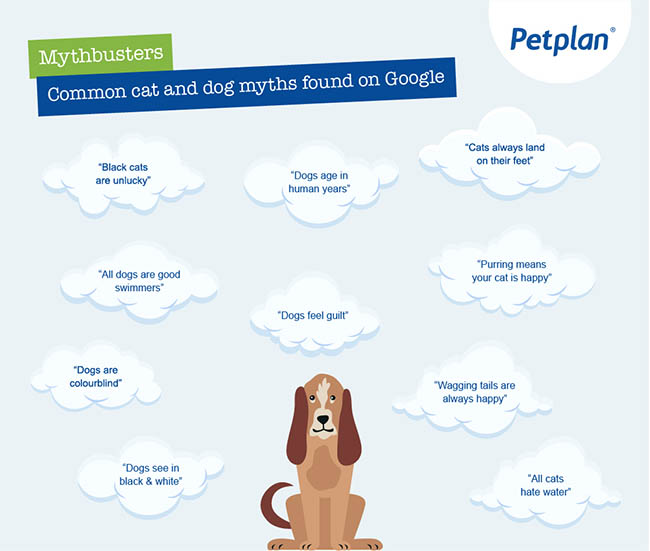
Above: Popular pet myths based on Google search queries
We might think we know everything about our precious pets. But just as you can teach an old dog new tricks, we pet owners can also sharpen our knowledge.
Let’s explore some of the commonly held beliefs about our beloved buddies.
“A wagging tail means a happy dog”
We love to see our pooches in a pleasant mood, and almost half (49%) the pet owners we polled believe that a wagging tail equals a happy dog. In fact, the figure rises to a majority (51%) among women (including pet owners and non-pet owners), climbing to 55% in Yorkshire and the Humber and 57% in Leeds.
In reality, a wagging tail can convey a range of emotions, not just happiness – but also nervousness or insecurity.
“While many people assume a wagging tail is a sign of happiness, it's actually more nuanced than this” says Nick Jones, Dog Expert Witness and Behaviourist.
“Dogs use their tails, alongside other body language cues, to convey a range of emotions—from excitement and happiness to nervousness or anxiety. The speed, position, and accompanying signals like posture or ear position are key to understanding how a dog truly feels. Rather than viewing a wag as a simple sign of friendliness, it’s better seen as an indication that the dog is open to interaction.”
“Pets licking their wounds helps to keep it clean”
When our pets get a bump or a graze, they don’t have the option of running a bath for a soothing soak. So it’s understandable why many people (31%) believe that pets can keep their wounds clean at the tip of their tongue.
This view is widespread: 40% of respondents in Wales – and 35% of people aged over 55 – believe that licking wounds is beneficial for cleanliness. In fact, pet owners were even more likely than non-pet owners (33% versus 29%) to hold this opinion.
But here’s the thing: by licking their wounds, pets are more actually likely to infect their wounds than prevent one.
“Licking causes physical trauma to the skin’s natural barrier, which allows bacteria to enter the wound and even the body. Bacteria thrive in dog and cats’ mouths. These bacteria may originate from leftover food particles, dental plaque, and less hygienic habits, such as drinking from dirty puddles and licking their own bottoms.” says Petplan vet expert, Dr Brian Faulkner.
“Cats’ tongues are particularly rough which can cause significant damage and trigger a skin infection, abscess or generalised sepsis. That’s why vets advise pet owners to prevent their cats from licking their wounds. Similarly, dogs will lick themselves to clean their coats, ease itchy skin or relieve pain, which unfortunately in some cases can lead to infection.”
“Dogs don’t see in colour”
We all know that dogs have a great sense of smell, but do their eyes deceive them?
More than a fifth (21%) of people we polled believe that dogs don’t see in colour. In fact, this view was more likely among dog owners themselves (24%), while Gen Z (16-24 year-olds) were the likeliest age group (27%) to hold this belief.
It’s a bright and beautiful world out there, but can dogs really only see in black and white? Answer: no. Dogs can see colours, albeit not as many colours or shades as we can, and they perceive colours with less intensity.
So much for loyalty?
It’s not for nothing that dogs earned the nickname ‘man’s best friend’. And while cats are famous for doing their own thing, we like to believe that our pets will stand shoulder-to-shoulder – or at least paw-to-shoulder – by our side.
We asked people which dog and cat breeds are in it fur the long haul. Leaving aside the ‘unsure’ and ‘other’ responses, here’s what they told us.
Which dog and cat breed do you believe is the most loyal?
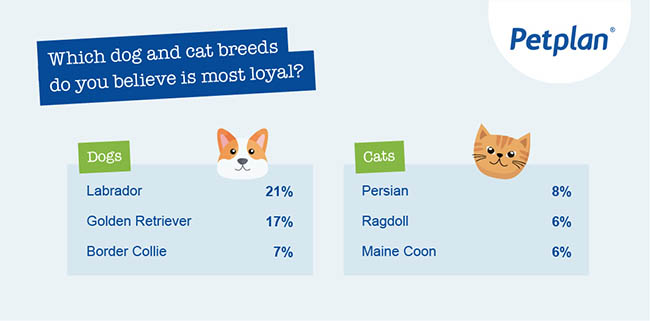
Top dog and cat breeds that people believe are most loyal
But do pets actually feel a sense of loyalty?
Almost half (47%) of people told us they don’t believe that a specific cat breed is any more loyal than another – and 44% of cat owners agreed.
Even with dogs, 27% of respondents – including 24% of dog owners – said they don’t believe that one dog breed can be described as more loyal.
But it’s fair to say there were differing views across the generations. 39% of people aged 55+ said ‘I do not believe any specific dog breed is the most loyal compared to others’, while just 15% of Gen Z (16-24) answered the same.
The truth is that cats and dogs do form strong bonds with their owners (but we knew that already, right?) Here’s a surprise though: a 2019 Oregon State University study found that cats can be just as loyal as dogs; in fact, cats “display the same main attachment styles as babies and dogs”.
The best of enemies?
Sure, cats and dogs enjoy their fair share of running battles. But do we see this as a love-hate relationship? We asked the public what they make of the cat-dog dynamic.
Do you agree or disagree that ‘cats and dogs are natural enemies’?
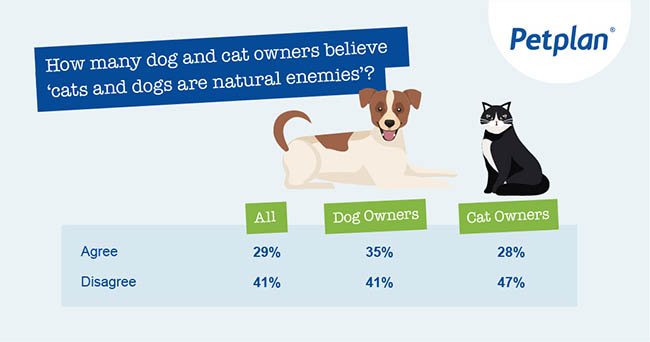
How many people believe dog and cat owners are natural enemies
Leeds was the city where people were most likely (38%) to say that cats and dogs are ‘natural enemies’, while Liverpool and Brighton (both 19%) were the least likely to agree.
But what’s the truth behind this ‘paw’ of attrition? The reality is nuanced.
“While some cats and dogs don’t get along, many dogs can live harmoniously with cats, depending on their temperament, and how they have been introduced to each other” says Brian. “It's essential to consider the personalities of both pets before deciding to bring them into the same household.
Separating myth from reality
We’ve explored which pet stories are true, and which are tall tales. But are these pet myths harmless, or do they actually influence how we interact with our furry friends?
What actions have you taken based on pet myths?
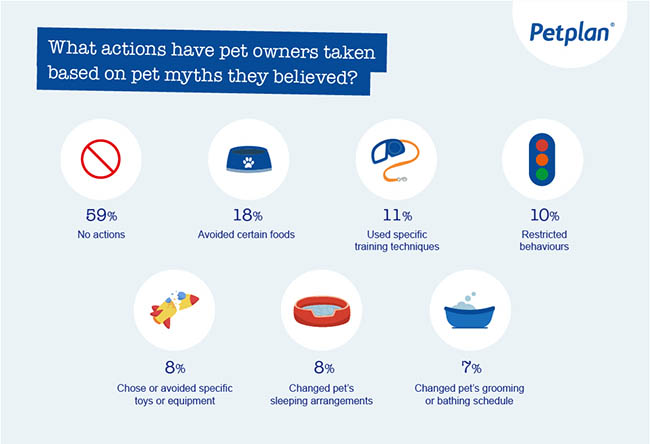
What actions have pet owners taken based on pet myths they believed?
When it comes to choosing a cat or dog breed, younger millennials (25-34) were the most likely to have been swayed by a pet myth (28%), followed by Gen Z (24%).
But while some myths are hard to shake off, most pet owners expressed confidence in their ability to separate fact from fiction.
- Pet owners like to get on with it. 50% said that believing a myth has never affected how they interact with a pet.
- A majority (69%) of pet owners said they’re ‘very’ or ‘somewhat’ confident in their ability to distinguish between pet care myths and facts. Just 39% of non-pet owners answered in the same way.
- Pet owners are willing to adapt. 62% said they would consider (or be certain to) change their current pet care routine if they discovered what they were doing was based on a myth. This rose to 72% among Gen Z.
How confident are you in distinguishing between pet care myths and facts?
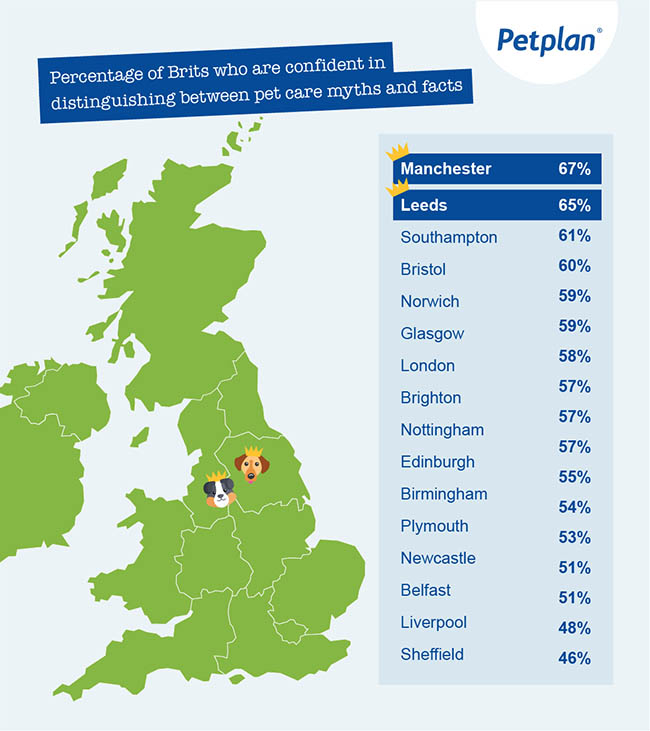
Percentage of Brits who are confident in distinguishing between pet care myths and facts across the UK - map
Regionally, people in Manchester expressed the highest net confidence (67%) when it comes to distinguishing between pet care myths and facts. Sheffield was the least confident city (46%).
And what happens to our habits after debunking a myth? Bristol was the least likely UK city to change their pet routine (47%) while Leeds was the most likely (69%).
Is your knowledge up to scratch?
It’s no secret that cats don’t have nine lives, and dogs can’t exactly bark up the wrong tree. But we hope to have busted some pet myths to give you a better sense of what your beloved pet is thinking, and how they read your behaviour.
“There are so many myths about pets that it's easy to see why people might be confused. From interpreting a wagging tail to understanding their nutritional needs, these misconceptions can impact how we care for our animals.
“It's essential to look beyond the myths and really get to know our pets as individuals, understanding their behaviours and what these mean in specific circumstances. And while some myths may seem harmless, others can turn out to be costly mistakes, which is why having the right support, like pet insurance, can offer peace of mind. The more informed we are, the better we can respond to their needs and ensure their happiness and well-being.” says Petplan vet expert Dr. Brian Faulkner.